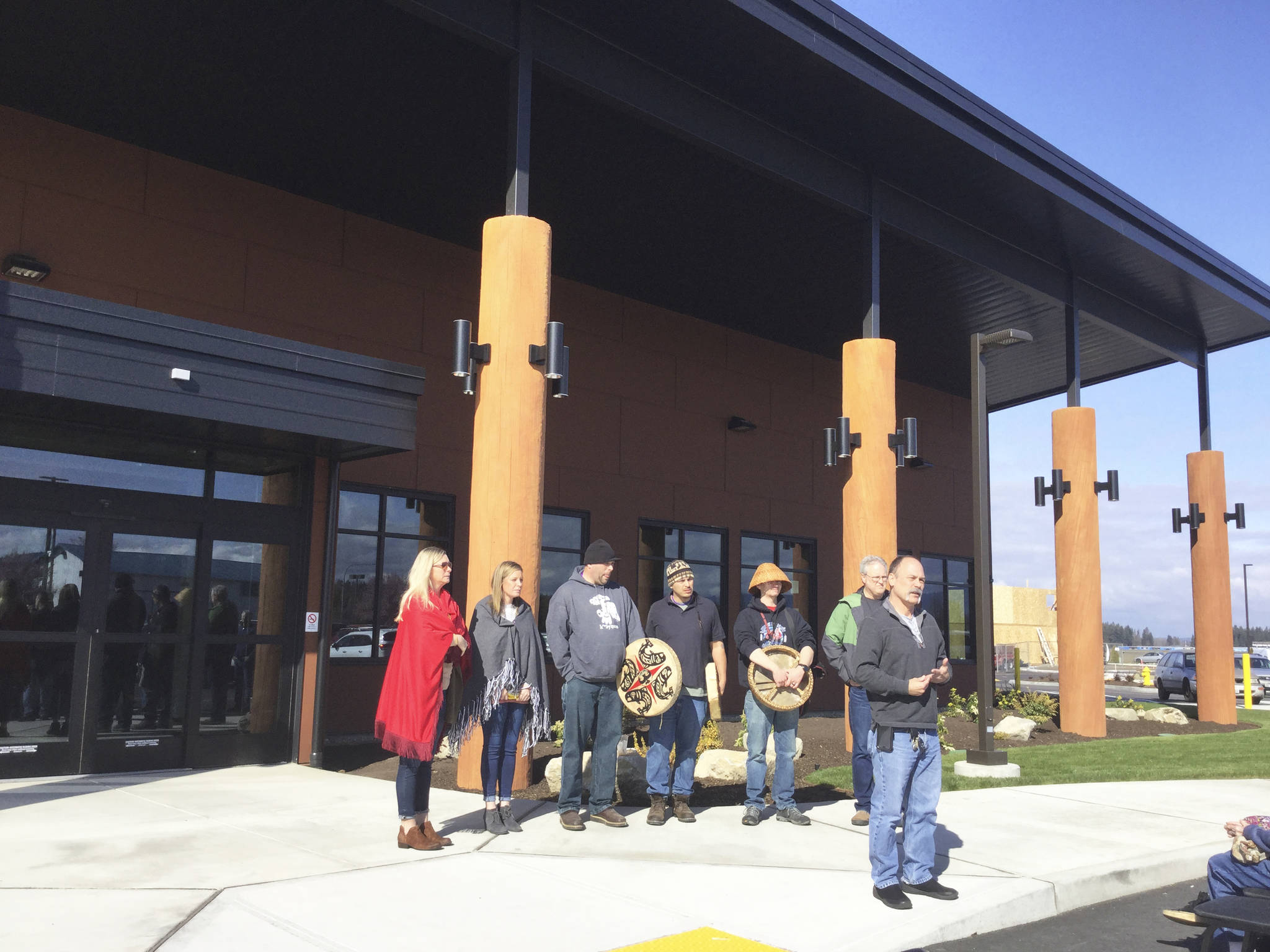ARLINGTON – In Stillaguamish Tribe folklore, tribal members used Quileute, a sacred and fragrant medicinal herb plucked from peat bogs near the river, to heal a variety of ailments and create a general state of well-being.
Stillaguamish tribal leaders celebrated the opening of a new methadone treatment and healing center with counseling services on Tuesday, accompanied by a blessing song from tribal drummers.
Keeping with their Native American customs, they christened the new facility Quileute, sometimes also known as Labrador tea.
“We thought it would be fitting to name the building in honor of that medicinal plant, and hope that the medicine will be helpful for those who attend this medical facility,” Tribal Chairman Shawn Yanity told the crowd of about 90 people.
The $14 million, two-story, 41,837-square-foot center is built on tribal trust land at 5700 172nd St. NE. It will provide outpatient services for those who report regularly for a dose of methadone, a synthetic opiate that helps people overcome drug addictions.
The building is a relocation of the Island Crossing Healing Center that the Tribe has operated at Highway 530 and Smokey Point Boulevard since 2003. At that time, it was one of only two tribal methadone clinics nationwide, but the first to open its doors to both Indian and non-Indian patients, Yanity said.
The new healing center officially opens on Tuesday. Basic services include outpatient medication-assisted treatment for opiate addicts through the use of methadone, augmented by a series of classes, counseling services and group therapy intended to help break the physical habits of taking pill or injecting opiates, and prevent clients from relapsing.
The center will start with 35 employees, but could almost double as demand for services dictates, officials said.
Kelly Campbell, director of Behavioral Health Programs, said the center will serve about 750 patients when it opens, with a likely increase to 900.
With 10 meeting rooms, clinical supervisor Jackie Roth said staff will now be able to offer more educational training, relapse prevention groups sub-divided by social support for women only or co-ed, and a contemplation track that can either put clients on the methadone outpatient program or a six-week “turning point” program.
The center’s clientele are predominantly women and non-native, so Roth and Campbell are working to launch a child drop-off room at the center where kids can be supervised when a parent or guardian is dosing or receiving counseling.
Campbell said the center is also talking with state officials to look into offering primary care in the future.
Jeremy Smith, Stillaguamish Tribe facilities manager, said he is impressed with the main check-in area’s six automatically closing soundproof stalls that offer clients and docents privacy. He said the previous center’s activities made those connections a challenge.
Yanity said when the Stillaguamish opened the original center, Snohomish County had more than 2,000 people ordered by the courts to undergo drug treatment, with only two facilities in the region at the time, which had the resources to serve 350 clients. Yanity explained that’s why the Tribe stepped forward to support its own people and others battling addiction.
From the main entrance, the new center consists of intake, outpatient assessment and services on the first floor, with support staff and administrative offices on the second. The south wing has a separate entrance and will house the Behavioral Health Program’s drug treatment program, which currently runs in a separate office building within view to the east on 59th.
Everett-based contractor Gaffney Construction built the facility with similar design concepts used for the Stillaguamish Tribe Administrative Building project in 2016 and community center a year earlier. Smith said the Stillaguamish wanted to create a uniform theme throughout its buildings that reflects the tribe’s identity.
To that end, the exterior uses earthy tones, stonework, wood and pillars reminiscent of a tribal longhouse, while inside contains open-air ceilings for natural lighting, and with tribal artifacts, paddles and photo images of canoeing that connote a journey.
“Our culture is very healing,” Yanity said. “We don’t want this to be a doctor facility. We want people to be able to come in and be comforted.”
Heroin use has reached crisis proportions in the county. Health district statistics, from 2011-2015, show there were 732 opioid-related deaths in the five-county north sound region; Snohomish County accounted for 545 with Whatcom the next closest with 77 deaths. The Stillaguamish clinic is one of only three methadone clinics in Snohomish County, and the only one between the north county and the U.S.-Canada border, with some clients driving from Bellingham and Blaine daily for treatment. The Swinomish Indian Tribe wellness center expanded its treatment services and began serving the public last November.
Despite some people who believe that the methadone clinic will draw people to the region, Yanity said: “They’re already here. We’ve got to give them some options. We’ve seen the success with people coming through the program, where they’re able to function back in a job, back in the community.”



